Small overlap front: driver-side
Rating applies to 2015-20 models
Tested vehicle: 2015 Nissan Pathfinder SV 4-door 4wd
The Nissan Pathfinder was redesigned for the 2013 model year, and the Infiniti JX35, a luxury version of the Pathfinder, was introduced in the 2013 model year. Beginning with 2014 models, the JX35 was renamed the QX60. Beginning with 2015 models of both the Pathfinder and QX60, the front-end structure was modified to improve occupant protection in small overlap frontal crashes.
| Evaluation criteria | Rating |
|---|---|
| Structure and safety cage | |
| Driver injury measures | |
| Head/neck | |
| Chest | |
| Hip/thigh | |
| Lower leg/foot | |
| Driver restraints and dummy kinematics | |
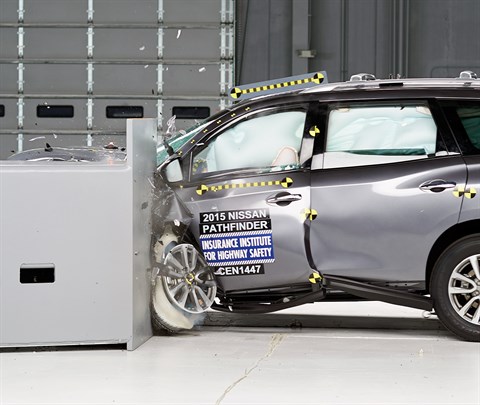
Action shot taken during the driver-side small overlap frontal crash test.

The dummy's position in relation to the door frame, steering wheel, and instrument panel after the crash test indicates that the driver's survival space was maintained well.

The frontal and side curtain airbags worked well together to keep the head from coming close to any stiff structure or outside objects that could cause injury.

The driver's space was maintained well, and risk of injuries to the dummy's legs and feet was low.
Small overlap front: passenger-side
Rating applies to 2015-20 models
Tested vehicle: 2018 Nissan Pathfinder S 4-door 4wd
The Nissan Pathfinder was redesigned for the 2013 model year, and the Infiniti JX35, a luxury version of the Pathfinder, was introduced in the 2013 model year. Beginning with 2014 models, the JX35 was renamed the QX60. Beginning with 2015 models of both the Pathfinder and QX60, the front-end structure was modified to improve occupant protection in small overlap frontal crashes.
| Evaluation criteria | Rating |
|---|---|
| Overall evaluation | |
| Structure and safety cage | |
| Passenger injury measures | |
| Head/neck | |
| Chest | |
| Hip/thigh | |
| Lower leg/foot | |
| Passenger restraints and dummy kinematics | |
| Driver injury measures | |
| Head/neck | |
| Chest | |
| Hip/thigh | |
| Lower leg/foot | |
| Driver restraints and dummy kinematics | |
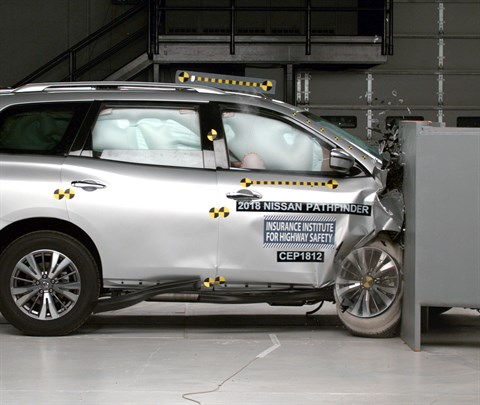
Action shot taken during the passenger-side small overlap frontal crash test.
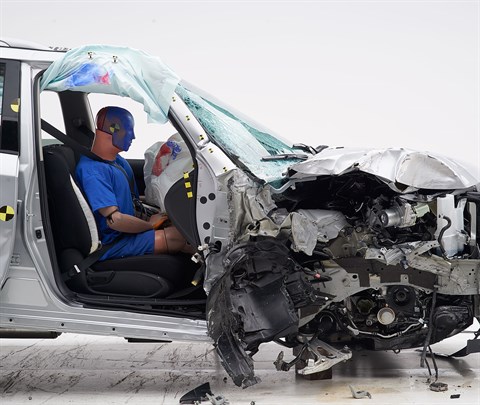
The dummy's position in relation to the door frame and dashboard after the crash test indicates that the passenger’s survival space was not maintained well.
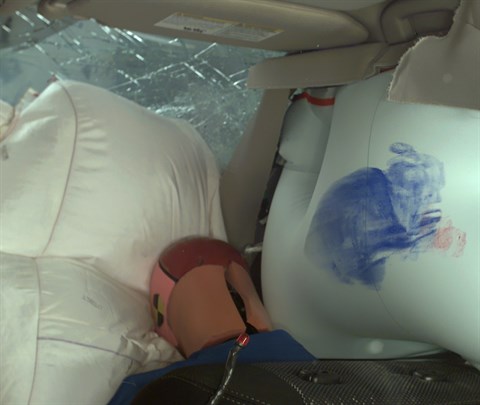
The frontal and side curtain airbags worked well together to keep the passenger dummy’s head from coming close to any stiff structure or outside objects that could cause injury.
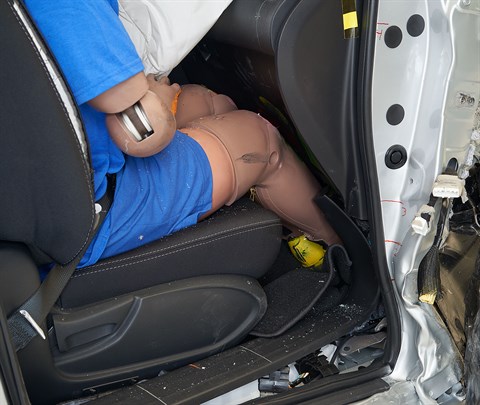
Despite intrusion of the door hinge pillar and dashboard, risk of injuries to the dummy's legs and feet was low.
Moderate overlap front: original test
Rating applies to 2014-20 models
Tested vehicle: 2014 Nissan Pathfinder Platinum 4-door 4wd
The Nissan Pathfinder was redesigned for the 2013 model year, and the Infiniti JX35, a luxury version of the Pathfinder, was introduced in the 2013 model year. Beginning with 2014 models, the JX35 was renamed the QX60.
Moderate overlap frontal ratings are assigned by the Institute based on two tests conducted by Nissan. The first test was conducted on a 2013 model Pathfinder and the second test on a 2014 model Pathfinder. Ratings apply to all Pathfinders beginning with the 2013 model year, the JX for the 2013 model year, and all QX models beginning with 2014.
| Evaluation criteria | Rating |
|---|---|
| Overall evaluation | |
| Structure and safety cage | |
| Driver injury measures | |
| Head/neck | |
| Chest | |
| Leg/foot, left | |
| Leg/foot, right | |
| Driver restraints and dummy kinematics | |
Side: original test
Rating applies to 2014-20 models
Tested vehicle: 2014 Nissan Pathfinder SV 4-door 4wd with standard head curtain airbags for all three rows of seats and standard front seat-mounted torso airbags
The Nissan Pathfinder was redesigned for the 2013 model year, and the Infiniti JX35, a luxury version of the Pathfinder, was introduced in the 2013 model year. Beginning with 2014 models, the JX35 was renamed the QX60, and both the Pathfinder and QX60 received side curtain airbag and rear door structural modifications to improve occupant protection in side impact crashes. Side ratings are assigned by the Institute based on a test conducted by Nissan.
| Evaluation criteria | Rating |
|---|---|
| Overall evaluation | |
| Structure and safety cage | |
| Driver injury measures | |
| Head/neck | |
| Torso | |
| Pelvis/leg | |
| Driver head protection | |
| Rear passenger injury measures | |
| Head/neck | |
| Torso | |
| Pelvis/leg | |
| Rear passenger head protection | |
Roof strength
Rating applies to 2015-20 models
Tested vehicle: 2015 Nissan Pathfinder SV 4-door 4wd
| Overall evaluation | |
|---|---|
| Curb weight | 4,431 lbs |
| Peak force | 20,719 lbs |
| Strength-to-weight ratio | 4.68 |
Head restraints & seats
Seat type: Power cloth seat
| Overall evaluation | |
|---|---|
| Dynamic rating | |
| Seat/head restraint geometry |
About the head restraint & seat test
Currently, IIHS tests apply only to front seats.
Headlights
Ratings are given for 6 different headlight variations available on this vehicle.
Trim level(s)
- Luxe trim; built after May 2019
| Evaluation criteria | Rating |
|---|---|
| Low-beam headlight type | LED projector |
| High-beam headlight type | LED projector |
| Curve-adaptive? | No |
| High-beam assist? | Yes |
|
Overall rating | |
| Distance at which headlights provide at least 5 lux illumination: | |
Low beams
On the straightaway, visibility was fair on both sides of the road. On curves, visibility was fair on the sharp left and both right curves and inadequate on the gradual left curve.
The low beams never exceeded glare limits.
High beams
On the straightaway, visibility was good on the right side of the road and fair on the left side. On curves, visibility was inadequate in all 4 tests.
High-beam assist compensates for some limitations of this vehicle's low beams on the straightaway, on both left curves and on the gradual right curve.
Trim level(s)
- Pure trim; built after May 2019
| Evaluation criteria | Rating |
|---|---|
| Low-beam headlight type | LED projector |
| High-beam headlight type | LED projector |
| Curve-adaptive? | No |
| High-beam assist? | No |
|
Overall rating | |
| Distance at which headlights provide at least 5 lux illumination: | |
Low beams
On the straightaway, visibility was fair on both sides of the road. On curves, visibility was fair on the sharp left and both right curves and inadequate on the gradual left curve.
The low beams never exceeded glare limits.
High beams
On the straightaway, visibility was good on the right side of the road and fair on the left side. On curves, visibility was inadequate in all 4 tests.
Trim level(s)
- Luxe trim; built before September 2018
| Evaluation criteria | Rating |
|---|---|
| Low-beam headlight type | HID projector |
| High-beam headlight type | HID projector |
| Curve-adaptive? | No |
| High-beam assist? | Yes |
|
Overall rating | |
| Distance at which headlights provide at least 5 lux illumination: | |
Low beams
On the straightaway, visibility was good on both sides of the road. On curves, visibility was good on the sharp left and both right curves and fair on the gradual left curve.
The low beams created excessive glare.
High beams
On the straightaway, visibility was fair on both sides of the road. On curves, visibility was fair in all 4 tests.
High-beam assist compensates for some limitations of this vehicle's low beams on both left curves.
Trim level(s)
- Pure trim; built before September 2018
| Evaluation criteria | Rating |
|---|---|
| Low-beam headlight type | HID projector |
| High-beam headlight type | HID projector |
| Curve-adaptive? | No |
| High-beam assist? | No |
|
Overall rating | |
| Distance at which headlights provide at least 5 lux illumination: | |
Low beams
On the straightaway, visibility was good on both sides of the road. On curves, visibility was good on the sharp left and both right curves and fair on the gradual left curve.
The low beams created excessive glare.
High beams
On the straightaway, visibility was fair on both sides of the road. On curves, visibility was fair in all 4 tests.
Trim level(s)
- Luxe trim; built after August 2018 and before June 2019
| Evaluation criteria | Rating |
|---|---|
| Low-beam headlight type | LED projector |
| High-beam headlight type | LED projector |
| Curve-adaptive? | No |
| High-beam assist? | Yes |
|
Overall rating | |
| Distance at which headlights provide at least 5 lux illumination: | |
Low beams
On the straightaway, visibility was inadequate on both sides of the road. On curves, visibility was fair on both right curves and inadequate on both left curves.
The low beams never exceeded glare limits.
High beams
On the straightaway, visibility was good on the right side of the road and fair on the left side. On curves, visibility was fair on the gradual right curve and inadequate on the sharp right and both left curves.
High-beam assist compensates for some limitations of this vehicle's low beams on the straightaway and all 4 curves.
Trim level(s)
- Pure trim; built after August 2018 and before June 2019
| Evaluation criteria | Rating |
|---|---|
| Low-beam headlight type | LED projector |
| High-beam headlight type | LED projector |
| Curve-adaptive? | No |
| High-beam assist? | No |
|
Overall rating | |
| Distance at which headlights provide at least 5 lux illumination: | |
Low beams
On the straightaway, visibility was inadequate on both sides of the road. On curves, visibility was fair on both right curves and inadequate on both left curves.
The low beams never exceeded glare limits.
High beams
On the straightaway, visibility was good on the right side of the road and fair on the left side. On curves, visibility was fair on the gradual right curve and inadequate on the sharp right and both left curves.
